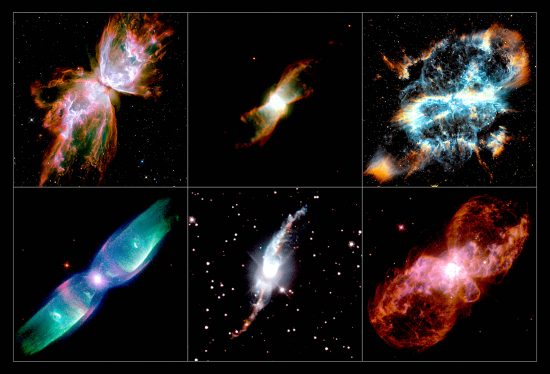
Oct 21, 2019
Temperature has little to do with electricity.
“Bipolar outflow” is a term used to describe twin-lobed nebular structures like the ones seen above. The cause of the effect remains baffling to astrophysicists, however. One theory suggests that the shapes are due to slow-moving stellar matter “crashing into” dust and gas ejected from red giant stars. Magnetic fields are sometimes invoked to describe lobate celestial objects, but the idea that electric charge flow is needed for their generation is neglected.
Astronomical theories cannot explain the mechanism that forms nebular clouds and energetic emissions. They do not know how stars throw off their outer layers, or how matter accelerates out from their polar axes. The reason for that lack of understanding is that nebulae are not composed of inert gas, cold or hot, but of plasma.
According to Electric Universe theory, bipolar formations are not puzzling or surprising. Rather, they are readily explicable and expected. From nebula to galaxy, hourglass configurations are one signature of electric currents flowing through plasma.
Gases obey Newtonian laws of kinetic motion with molecules bumping into each other or accelerated by “shock waves” imparted by other particles. Plasma, on the other hand, behaves according to the laws of electricity. Stars are born within twisting Birkeland currents that flow around a circuit through the galaxy. The z-pinch effect squeezes plasma inside those filaments, igniting stars and forming toroids of electricity around stellar equators. It is actually the electrical current density that causes plasma in nebulae to glow, not reflections or thermal emissions.
Nebulae sometimes reveal long tendrils and bubbles within their hourglass shapes. According to conventional theories, those features are the result of stellar winds blowing off the parent star, impacting into the slower material ahead of them. The unmistakeable appearance of Birkeland current filaments is clearly visible. The overall configuration corresponds to the helices and pillars that electrical discharges in plasma can create.
In the laboratory, plasma forms cells separated by thin walls of opposite charge called double layers. Could separation of charges also take place in nebulae? That question might take a long time to resolve because the only way to detect a double layer in space is to insert a Langmuir probe into one.
Although no definitive answers are yet forthcoming, Electric Universe advocates assume that plasma will behave in space in the same way as it does in the laboratory. Electric double layers resulting from charge separation impelled Nobel laureate Hannes Alfvén to suggest that they have their own classification alongside stars and galaxies.
Stephen Smith
The Thunderbolts Picture of the Day is generously supported by the Mainwaring Archive Foundation.












